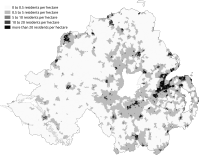
Back Démographie de l'Irlande du Nord French Demografia da Irlanda do Norte Portuguese Demografia Irlandei de Nord Romanian Население Северной Ирландии Russian 北愛爾蘭人口 Chinese
| Demographics of Northern Ireland | |
|---|---|
 Population pyramid of Northern Ireland in 2020 | |
| Population | 1,903,175 (2021 census) |
| Density | 133 per km2 |
| Life expectancy | |
| • male | 77.2 years |
| • female | 80.8 years |
| Age structure | |
| 0–14 years | 19% |
| 15–64 years | 64% |
| 65 and over | 17% |
| Nationality | |
| Major ethnic | White 97% |
| Minor ethnic | other ethnic groups 3% |

Northern Ireland is the smallest of the four components of the United Kingdom in terms of both area and population, containing 2.9% of the total population and 5.7% of the total area of the United Kingdom. It is the smaller of the two political entities on the island of Ireland by area and population, the other being the Republic of Ireland. Northern Ireland contains 27.1% of the total population and 16.75% of the total area of the island of Ireland.
The Belfast Metropolitan Area dominates in population terms, with over a third of the inhabitants of Northern Ireland.
When Northern Ireland was created, it had a Protestant majority of approximately two-to-one,[1][2][3] unlike the Republic of Ireland, where Catholics were in the majority.[4] The 2001 census was the first to show that the Protestant and other (non-Catholic) Christian share of the population had dropped below 50%, but 53.1% still identified as being from a Protestant or other Christian background. In the 2011 census, this dropped to 48.4%.[5][3] In 2021, the recorded number of Catholics by background (45.7%) overtook the Protestant and other Christian by background share (43.48%), becoming the plurality, with no group in the overall majority.[6][7][8][9]
Its people speak Irish (Gaelic), Ulster Scots and Ulster English which is itself heavily influenced by the Scots language of which Ulster Scots is a dialect. In addition the Ulster dialect of Irish (Gaelic) also has a closer connection to Scottish Gaelic than other Irish (Gaelic) dialects. This is both because of historic links with Scotland going back centuries, and because of settlements of lowland Scots Protestants in Ulster in the 17th century, such as the Plantation of Ulster.
Also unlike the Republic, a large proportion of people in Northern Ireland have a British national identity, although a significant minority identifies as Irish. Many people in Northern Ireland have a Northern Irish identity, whether in addition to a British or Irish identity or by itself.

- ^ Anderson, James; Shuttleworth, Ian (1998). "Sectarian demography, territoriality and political development in Northern Ireland". Political Geography. 17 (2): 187–208. doi:10.1016/S0962-6298(97)00035-8. ISSN 0962-6298. PMID 12348611.
- ^ Specia, Megan; O’Loughlin, Ed (22 September 2022). "Catholics Outnumber Protestants in Northern Ireland for the First Time". The New York Times.
- ^ a b Cooley, Laurence (30 August 2021). "Census politics in Northern Ireland from the Good Friday Agreement to Brexit: Beyond the 'sectarian headcount'?". The British Journal of Politics and International Relations. 23 (3): 451–470. doi:10.1177/1369148120959045. S2CID 228856031.
- ^ "More Catholics than Protestants in Northern Ireland for first time, census finds". The Irish Times.
- ^ "Communal counting: The Northern Ireland census". 6 March 2019.
- ^ "Census 2021: More from Catholic background in NI than Protestant". BBC News. 22 September 2022.
- ^ Pepper, Diarmuid. "'Historic' shift for Northern Ireland but what do the Census findings tell us about its future?". TheJournal.ie.
- ^ "Why drawing political claims from NI census is problematic". 26 September 2022 – via www.rte.ie.
{{cite journal}}: Cite journal requires|journal=(help) - ^ Coulter, Colin; Flaherty, Eoin; Shirlow, Peter (20 September 2023). "'Seismic' or stalemate? The (bio)politics of the 2021 Northern Ireland Census". Space and Polity. 27: 57–77. doi:10.1080/13562576.2023.2260153.
© MMXXIII Rich X Search. We shall prevail. All rights reserved. Rich X Search